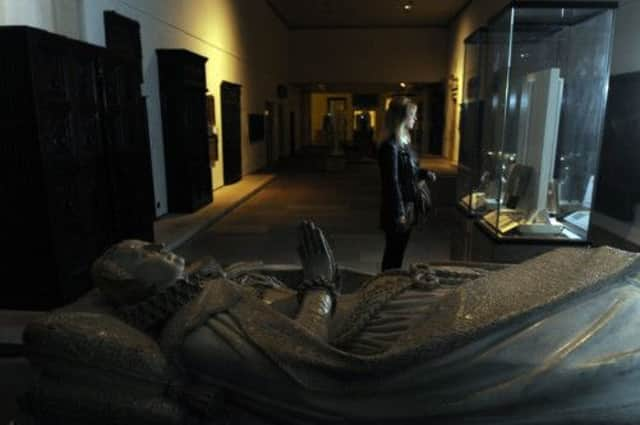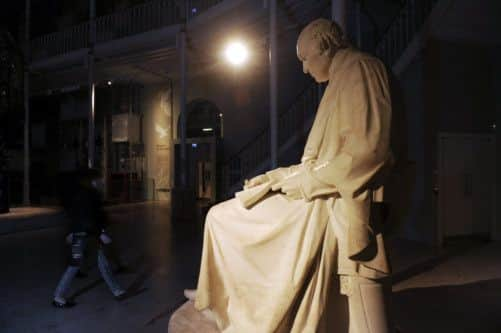A Night at the Museum: What’s the appeal?


AS MY eyes adjust to the low light, I spot the distinctive silhouette of a guillotine looming ahead of me. Sinister at the best of times, the macabre 16th century construction – known as The Maiden – wears an extra cloak of spookiness under the cover of semi-darkness. With today marking the start of the UK-wide Museums at Night festival – which sees museums across the country opening after dark – I’m at the National Museum of Scotland in Edinburgh to find out why we’re so taken with the idea.
The 2006 children’s film Night at the Museum sees a young father get a job as a night watchman at the Museum of Natural History in New York. After dark, the exhibits – dinosaurs, stuffed animals, an Easter Island Maoi – come to life and run riot in the hallowed halls. Just as the idea that toys come to life when their owners go to sleep holds allure for children, the notion that exhibits in a museum might have some secret after-hours life is a powerful one. And the sense of fun which comes from exploring your favourite museum after the lights have gone out is something which appeals to adults, too, says Nick Stockman, the project manager of the Museums at Night festival.
Advertisement
Hide Ad“That feeling of being in a place you’re not usually allowed into at certain times creates a bit of a buzz,” he says. “As the light is lost and darkness falls everyone gets that feeling that there’s something special in the air; you’re in a place that normally you wouldn’t be in. When you add that you have permission to do something different there, that’s what gives it its magic for me.”


There are more than 500 events across the UK as part of the festival, and the “something different” ranges from sleep-overs and DJs to live performances and torch-lit tours. Gigs, plays and poetry recitals will also be taking place throughout the weekend.
Last year’s festival saw everything from a late-night opening of the Christian Louboutin at the Design Museum to Scottish rock group Django Django in the Museum of Scotland, food artists Bompas and Parr floating the SS Great Britain on a sea of jelly and Polly Morgan performing taxidermy in front of a live audience in Liverpool. This year, ten of the UK’s leading contemporary artists – including Turner Prize-winning artist Martin Creed, Jake and Dinos Chapman, Gavin Turk, Mat Collishaw and sculptor and installation artist Richard Wentworth – have signed up to put on one-off events as part of the festival.
Back at the National Museum of Scotland, I’m face to face with a glass-encased Dolly the sheep, who looks like an extra from a horror film in the gloomy twilight. In the distance one of the museum’s clocks chimes the hour. I wander past it later, its pendulum casting a blurry shadow on the wall.
A suit of armour appears to move in the half-darkness. The ancient, battered taxidermy, twisted into action poses, seem suddenly uncomfortably alive. A wooden medieval crib, charming in the daylight, is ghoulish in the gloaming.
There’s no doubt that there’s a sense of magic to being in a museum after hours. The Museums at Night festival has been running since 2009 when 157 events played host to 34,000 visitors. Now in its fifth year, the 2013 festival is expected to attract more than 120,000 visitors. The festival ties in with a similar European event, La Nuit des Musées. On the continent, there are fewer free museums and art galleries than in the UK. The novelty, therefore, comes from getting in for free for one weekend only.
Advertisement
Hide AdHere, where most major galleries and museums are free to enter anyway, the focus is on showcasing collections at a different time and in a different light, perhaps attracting a slightly different audience or giving a familiar audience the chance to see pieces from a new angle. The opportunity to visit a museum after dark is not an entirely new concept, however. In the 19th century, when people worked long hours, most workers had only the Sabbath off, a day on which many museums and galleries were closed.
Leisure time, therefore, was limited to weekdays after 8pm and if museums and galleries were to be accessible to the working classes they had to open in the evenings. The introduction of gas lighting made this a viable option and the National Museum of Scotland – then called the Edinburgh Museum of Science and Art – opened free of charge on certain evenings in the week.
Advertisement
Hide AdOpen until 10pm on Friday and Saturday evenings, the move was popular with some social reformers who hoped it would broaden people’s minds and offer an alternative to spending evenings in the pub. It proved to be a relatively successful project, however with the museum being warm, well-lit and one of the few places open on winter evenings in Edinburgh, it became a popular haunt with young people who were more interested in each other than the treasures on display.
A letter to the Evening Dispatch written in 1890 described the museum as being “invaded by an army of children … who never would trouble themselves looking at any of the exhibits, but who go specially for the purpose of meeting each other and seeing each other home.” Another visitor complained that he found “this magnificent building full of amorous schoolboys and girls, whose sole object in coming seemed to be to look at one another.”
A licensed bar didn’t help matters and particularly angered local temperance groups who were up in arms when the museum – and its adjacent bar – opened on New Year’s Day in 1891, doing a roaring trade since the city’s pubs were closed.
The bar eventually lost its licence thanks to the temperance campaigners, and the city’s teenagers found new places to meet and flirt. However, the museum’s after-hours ‘scene’ has been revived in recent years with a series of very successful RBS Lates evenings, which see bands playing and drinks being served while guests mingle among the exhibits.
Right now, however, it’s just me. I think I hear an echo in the distance, a cleaner finishing up for the night perhaps. Or the ghost with no knees that’s said to haunt the place. I wander past the replica of Mary Queen of Scots’ death mask, the last of the light catching her features.
It’s spooky, unnerving, haunting and just a little bit magical.
• For more information about the Museums at Night festival, which runs from today until Saturday, visit www.museumsatnight.org.uk